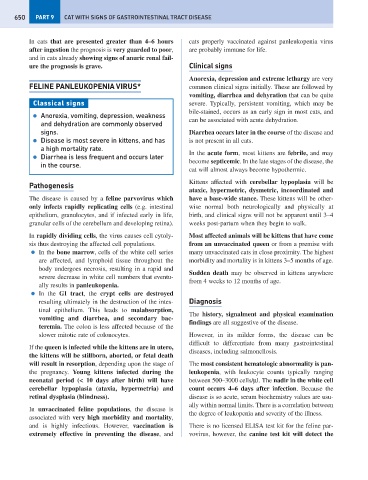Page 658 - Problem-Based Feline Medicine
P. 658
650 PART 9 CAT WITH SIGNS OF GASTROINTESTINAL TRACT DISEASE
In cats that are presented greater than 4–6 hours cats properly vaccinated against panleukopenia virus
after ingestion the prognosis is very guarded to poor, are probably immune for life.
and in cats already showing signs of anuric renal fail-
ure the prognosis is grave. Clinical signs
Anorexia, depression and extreme lethargy are very
FELINE PANLEUKOPENIA VIRUS* common clinical signs initially. These are followed by
vomiting, diarrhea and dehyration that can be quite
Classical signs severe. Typically, persistent vomiting, which may be
bile-stained, occurs as an early sign in most cats, and
● Anorexia, vomiting, depression, weakness
can be associated with acute dehydration.
and dehydration are commonly observed
signs. Diarrhea occurs later in the course of the disease and
● Disease is most severe in kittens, and has is not present in all cats.
a high mortality rate.
In the acute form, most kittens are febrile, and may
● Diarrhea is less frequent and occurs later
become septicemic. In the late stages of the disease, the
in the course.
cat will almost always become hypothermic.
Kittens affected with cerebellar hypoplasia will be
Pathogenesis
ataxic, hypermetric, dysmetric, incoordinated and
The disease is caused by a feline parvovirus which have a base-wide stance. These kittens will be other-
only infects rapidly replicating cells (e.g. intestinal wise normal both neurologically and physically at
epithelium, granulocytes, and if infected early in life, birth, and clinical signs will not be apparent until 3–4
granular cells of the cerebellum and developing retina). weeks post-partum when they begin to walk.
In rapidly dividing cells, the virus causes cell cytoly- Most affected animals will be kittens that have come
sis thus destroying the affected cell populations. from an unvaccinated queen or from a premise with
● In the bone marrow, cells of the white cell series many unvaccinated cats in close proximity. The highest
are affected, and lymphoid tissue throughout the morbidity and mortality is in kittens 3–5 months of age.
body undergoes necrosis, resulting in a rapid and
Sudden death may be observed in kittens anywhere
severe decrease in white cell numbers that eventu-
from 4 weeks to 12 months of age.
ally results in panleukopenia.
● In the GI tract, the crypt cells are destroyed
resulting ultimately in the destruction of the intes- Diagnosis
tinal epithelium. This leads to malabsorption,
The history, signalment and physical examination
vomiting and diarrhea, and secondary bac-
findings are all suggestive of the disease.
teremia. The colon is less affected because of the
slower mitotic rate of colonocytes. However, in its milder forms, the disease can be
difficult to differentiate from many gastrointestinal
If the queen is infected while the kittens are in utero,
diseases, including salmonellosis.
the kittens will be stillborn, aborted, or fetal death
will result in resorption, depending upon the stage of The most consistent hematologic abnormality is pan-
the pregnancy. Young kittens infected during the leukopenia, with leukocyte counts typically ranging
neonatal period (< 10 days after birth) will have between 500–3000 cells/μl. The nadir in the white cell
cerebellar hypoplasia (ataxia, hypermetria) and count occurs 4–6 days after infection. Because the
retinal dysplasia (blindness). disease is so acute, serum biochemistry values are usu-
ally within normal limits. There is a correlation between
In unvaccinated feline populations, the disease is
the degree of leukopenia and severity of the illness.
associated with very high morbidity and mortality,
and is highly infectious. However, vaccination is There is no licensed ELISA test kit for the feline par-
extremely effective in preventing the disease, and vovirus, however, the canine test kit will detect the

